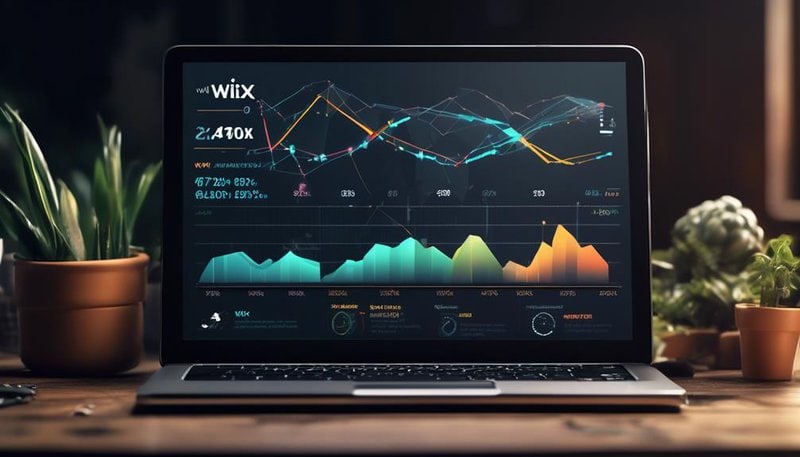How to Use Wix Analytics to Understand Your Audience

Wix Analytics is a powerful tool that allows you to gain valuable insights into your website visitors.
This tool can help you optimize your site and achieve your business goals.
Setting up Wix Analytics
To set up Wix Analytics, follow these steps to gain valuable insights into your website's audience.
- Navigate to the Wix Editor and click on the 'Settings' tab.
- From there, select 'Tracking & Analytics' and then click on 'Wix Analytics.'
- Next, you'll need to integrate Wix Analytics with your website by clicking on the 'Connect' button. This will allow you to start tracking user behavior and gathering data.
- Once the integration is complete, you can access Wix Analytics by going back to the 'Tracking & Analytics' section and selecting 'Wix Analytics.'
- Here, you'll find a wealth of information about your audience, including their demographics, interests, and behavior on your website.
- Take advantage of the various reports and dashboards available to gain insights into how visitors interact with your site.
- By tracking user behavior, you can make informed decisions to optimize your website and improve user experience.
- With Wix Analytics, you have the power to understand your audience and align your website to meet their needs.
Understanding Website Traffic
To understand your website traffic, you need to analyze the sources of your traffic, the popularity of your content, and the engagement of your visitors.
By breaking down the traffic sources, you can identify which channels are driving the most visitors to your site.
Analyzing the popularity of your content allows you to determine which pages or posts are attracting the most attention.
And by measuring visitor engagement metrics such as time on page and bounce rate, you can gauge how effectively your website is capturing and retaining the interest of your audience.
Traffic Sources Breakdown
Gain valuable insights into your website's traffic by analyzing the breakdown of traffic sources using Wix Analytics. Understanding where your website traffic is coming from is crucial for making informed decisions about your marketing strategies. Wix Analytics provides a Traffic Sources Breakdown feature that gives you a comprehensive view of the different sources driving traffic to your site.
By examining the referral traffic analysis, you can identify which websites or platforms are referring visitors to your site. This information can help you optimize your partnerships and collaborations with other websites or influencers to drive more traffic.
In addition, the organic search insights provided by Wix Analytics allow you to understand how your website is performing in search engine results. You can gain valuable information about the keywords and phrases that are bringing visitors to your site through organic search.
Here is a breakdown of the different traffic sources you can analyze using Wix Analytics:
| Traffic Source | Description |
|---|---|
| Referral Traffic | Websites or platforms that refer visitors to your site |
| Organic Search | Visitors who find your site through search engine results |
| Direct Traffic | Visitors who directly type your website's URL |
| Social Media | Visitors who come from social media platforms |
| Email Marketing | Visitors who click on links from email campaigns |
Analyzing these traffic sources can help you identify areas of improvement and maximize your website's traffic potential. With Wix Analytics, you have the power to understand your audience better and make data-driven decisions to enhance your online presence.
Popular Content Analysis
Discover the most popular content on your website by analyzing the Popular Content feature in Wix Analytics. This powerful tool allows you to gain valuable insights into your content performance and audience preferences.
Here's how it works:
- Track page views: The Popular Content feature shows you which pages on your website are attracting the most views. This helps you understand what topics and formats resonate most with your audience.
- Identify top-performing posts: By analyzing the Popular Content feature, you can easily identify your top-performing blog posts or articles. This information allows you to create more of the content that your audience loves and engages with.
- Optimize your content strategy: Armed with the knowledge of your most popular content, you can optimize your content strategy to focus on topics and formats that drive the most traffic and engagement. This ensures that you're consistently delivering the content your audience craves.
Visitor Engagement Metrics
Understand the engagement of your website visitors through powerful metrics provided by Wix Analytics. By analyzing visitor engagement metrics, you can gain valuable insights into how users interact with your website and identify areas for improvement. These metrics can help you optimize your visitor engagement strategies and enhance the overall user experience on your website.
Here are three key visitor engagement metrics to focus on:
| Metric | Description |
|---|---|
| Bounce Rate | The percentage of visitors who leave your site after viewing one page. |
| Average Session Duration | The average amount of time visitors spend on your site. |
| Pages per Session | The average number of pages visitors view during a session. |
Tracking Visitor Behavior
When it comes to tracking visitor behavior on your website, there are a few key points to consider.
First, you should analyze the number of page views and clicks to see which pages or elements are attracting the most attention.
Second, take a look at the average time visitors spend on your site to gauge engagement levels.
Lastly, keep an eye on the bounce rate, which indicates the percentage of visitors who leave your site after viewing only one page.
Page Views and Clicks
By tracking visitor behavior through page views and clicks, you gain valuable insights into your audience's actions and preferences. Understanding how users engage with your website is crucial for optimizing its performance and boosting conversion rates.
Here are three reasons why tracking page views and clicks is essential:
- Identify popular content: Tracking page views allows you to see which pages on your website are receiving the most traffic. This helps you understand what type of content resonates with your audience and can guide your content creation strategy.
- Analyze user flow: By analyzing the clicks made by visitors, you can gain insights into their browsing behavior and the paths they take on your website. This information allows you to optimize your website's navigation and improve user experience.
- Measure conversion rates: Tracking clicks on call-to-action buttons or links can help you measure the effectiveness of your conversion strategies. By identifying which elements are driving the most clicks, you can optimize your website to increase conversion rates.
Time on Site
After gaining insights into your audience's actions and preferences through page views and clicks, the next step is to track their time on site to further understand their behavior. By monitoring the duration visitors spend on your website, you can gauge their level of engagement and visitor retention. This information is crucial for optimizing your website's performance and enhancing user experience. The longer visitors stay on your site, the more likely they are to convert into customers or take desired actions. Below is an example of an engagement metrics table that can help you analyze your audience's time on site:
| Engagement Metrics | Average Time on Site | Bounce Rate |
|---|---|---|
| Overall | 2 minutes | 40% |
| Returning Visitors | 3 minutes | 30% |
| New Visitors | 1 minute | 50% |
Tracking the time on site allows you to identify opportunities for improvement and make data-driven decisions to increase visitor engagement and retention.
Bounce Rate
To effectively track visitor behavior and analyze engagement on your website, it's essential to understand and monitor the bounce rate. The bounce rate refers to the percentage of visitors who leave your site after viewing only one page. A high bounce rate indicates that visitors aren't finding what they're looking for or that your website isn't engaging enough.
Here are three ways to improve your bounce rate and keep visitors on your site:
- Optimize page load times: Slow loading pages can frustrate visitors and make them more likely to bounce. Ensure your website is fast and responsive.
- Provide relevant and engaging content: Make sure your website offers valuable and engaging content that matches what visitors are searching for. This will encourage them to stay and explore further.
- Improve website navigation: Make it easy for visitors to find what they're looking for by improving your website's navigation and user experience.
Analyzing User Engagement
To gain valuable insights into your website's performance, analyze user engagement using Wix Analytics. Understanding how users interact with your site can help you optimize its design and content to increase user retention and conversion rates. By analyzing user engagement metrics, you can identify areas for improvement and make data-driven decisions to enhance your website's performance.
One important metric to consider is the average time spent on your site. This metric indicates how engaged users are with your content. A longer average time spent on your site suggests that users find your content valuable and are more likely to convert. On the other hand, a short average time spent may indicate that users are quickly leaving your site, which could negatively impact your conversion rate.
Another metric to analyze is the page views per session. This metric reveals how many pages users visit during a single session on your site. A higher number of page views per session indicates that users are exploring your site extensively, which can lead to increased user retention and higher chances of conversion.
Lastly, analyzing the bounce rate can provide insights into user engagement. The bounce rate represents the percentage of users who leave your site after viewing only one page. A high bounce rate may indicate that users aren't finding what they're looking for or that your site's design needs improvement. By reducing the bounce rate, you can increase the chances of users staying on your site and converting.
Analyzing user engagement through metrics like average time spent on site, page views per session, and bounce rate can help you understand how users interact with your website. Armed with this knowledge, you can make informed decisions to optimize your site and improve user retention and conversion rates.
Monitoring Traffic Sources
Understanding user engagement is crucial for optimizing your website's performance, and an important aspect of this is monitoring traffic sources. By analyzing referral sources, you can gain valuable insights into where your website traffic is coming from and make strategic decisions to optimize traffic flow.
Here are three reasons why monitoring traffic sources is essential for your website's success:
- Identifying high-performing channels: By monitoring traffic sources, you can identify which channels are driving the most traffic to your website. This allows you to focus your efforts on those channels that are bringing in the most visitors and potentially convert them into customers.
- Discovering untapped opportunities: Monitoring traffic sources helps you identify new referral sources that you may not have considered before. By analyzing the data, you can uncover untapped opportunities to drive more traffic to your website and expand your reach.
- Optimizing marketing campaigns: By tracking the effectiveness of your marketing campaigns through traffic sources, you can optimize your strategies to increase conversions and improve ROI. You can analyze which campaigns are driving the most traffic and adjust your efforts accordingly.
Identifying Audience Demographics
One key aspect of optimizing your website's performance is gaining insight into your audience demographics. Understanding who your audience is and what they want is crucial for effective targeting strategies and user behavior analysis. With Wix Analytics, you can easily identify the demographics of your website visitors.
Wix Analytics provides valuable data on your audience's age, gender, location, and interests. This information allows you to tailor your content and marketing efforts to better resonate with your target audience. For example, if you discover that a significant portion of your visitors are in a certain age group, you can create content that appeals specifically to them.
Making Data-Driven Decisions
By leveraging the data provided by Wix Analytics, you can confidently make data-driven decisions to optimize your website's performance. With access to valuable insights about your audience, you can analyze their behavior and preferences to inform your decision-making process.
Here are some key benefits of using data analysis techniques and audience segmentation strategies:
- Improved targeting: By segmenting your audience based on various criteria such as demographics, interests, and behavior, you can tailor your website content and marketing campaigns to specific groups. This ensures that you're delivering the right message to the right people, resulting in higher engagement and conversion rates.
- Identifying trends and patterns: Wix Analytics provides you with detailed reports and visualizations that allow you to identify trends and patterns in your audience's behavior. By analyzing this data, you can uncover valuable insights such as peak traffic times, popular content, and conversion funnels. This information can help you optimize your website and marketing strategies to maximize results.
- Measuring and tracking performance: Wix Analytics enables you to set up goals and track their performance over time. By monitoring key metrics such as bounce rate, conversion rate, and average session duration, you can assess the effectiveness of your website and marketing efforts. This data-driven approach allows you to make informed decisions and adjust your strategies accordingly.
Frequently Asked Questions
Can Wix Analytics Track the Performance of Specific Webpages on My Website?
Yes, Wix Analytics can track the performance of specific webpages on your website. It provides valuable data for tracking website traffic and analyzing user behavior, giving you the insights you need to optimize your site.
How Can I Use Wix Analytics to Measure the Effectiveness of My Marketing Campaigns?
To measure the effectiveness of your marketing campaigns using Wix Analytics, you can analyze user behavior in different ways and set up goals to track conversions. Gain insights and freedom with Wix Analytics.
Is It Possible to Track the Conversion Rates of My Website Using Wix Analytics?
Yes, you can track conversion rates and measure your website's performance using Wix Analytics. It provides valuable insights on how your marketing efforts are translating into actual results.
Can Wix Analytics Provide Insights on the Most Popular Products or Services on My Website?
Wix Analytics offers user engagement analysis, revealing insights on the most popular products or services on your website. Gain valuable data to make informed decisions and optimize your offerings for maximum impact.
How Can I Use Wix Analytics to Identify the Geographic Locations of My Website Visitors?
Want to know where your website visitors are from? Use Wix Analytics to easily identify their geographic locations. It provides valuable insights on user behavior and engagement, helping you understand your audience better.










